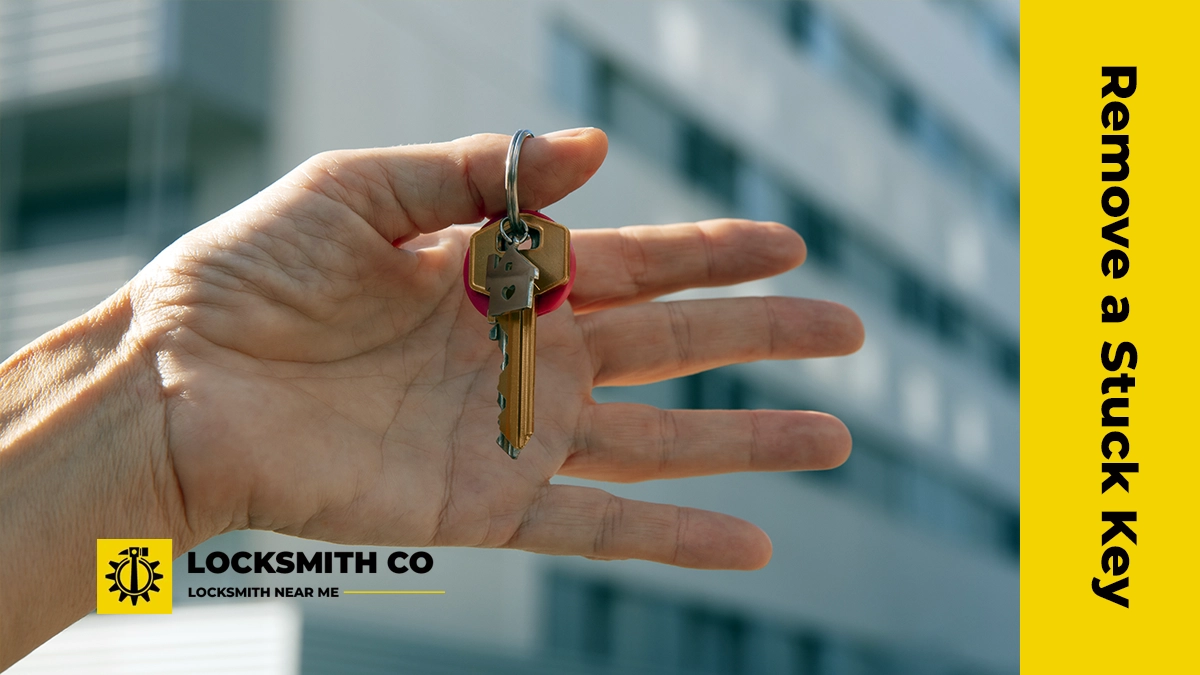Common Lock issues demystified: When to DIY and when to call a professional locksmith. From…
How to Safely Remove a Stuck Key: Expert Tips from Locksmith CO
How to safely remove a stuck key: Expert tips from Locksmith CO. Experiencing a key stuck in a lock is a common issue that can disrupt your day and test your patience.
Whether you’re a homeowner or renting a property, understanding how to remove a stuck key safely is crucial to avoiding further lock problems.
At Locksmith CO, we offer expert guidance and reliable services to help you address this pesky predicament with confidence.
How to Safely Remove a Stuck Key
In this article, we’ll provide you with practical, step-by-step advice on how to remove a stuck key and share preventative tips to ensure your locks function smoothly.
If the problem persists, our team of professional locksmiths in London is always ready to assist, ensuring your peace of mind and security.
Common Causes of a Stuck Key
Dirt and Debris Build-up
A frequent cause of a key becoming stuck in a lock is the accumulation of dirt and debris.
Over time, dust and grime can collect inside the lock mechanism, interfering with its smooth operation.
This build-up can create resistance when turning the key, resulting in it becoming jammed.
Regular maintenance of your locks can help prevent this issue. It’s advisable to periodically clean the keyhole using a can of compressed air to remove any loose particles.
Additionally, a small amount of graphite lubricant can be applied to the key before inserting it into the lock.
This will ensure that the internal mechanisms remain free-moving and less prone to sticking.
If you’ve encountered a key stuck in a lock due to dirt build-up, carefully cleaning the lock could resolve the problem.
However, if the issue persists, consulting a professional locksmith is recommended to avoid causing further damage.
Wear and Tear on Lock
Locks are subject to wear and tear over time, which can contribute to a key getting
stuck. Frequent usage, exposure to the elements, and lack of maintenance can cause the lock components to degrade.
As the internal parts wear down, they may not align as precisely as they once did, making it challenging to insert or turn the key smoothly.
This misalignment often results in a key becoming jammed. Regular inspection and maintenance can help mitigate this problem.
Consider lubricating your locks every few months with a suitable product to ensure they operate fluidly.
If you notice signs of wear, such as difficulty turning the key or visible damage to the lock, it might be time to replace the lock.
Ignoring these signs could lead to more significant lock problems.
Should you encounter persistent issues, seeking help from a professional locksmith ensures the correct and efficient resolution of any wear-related lock concerns.
Faulty Lock Mechanisms
Faulty lock mechanisms can be a significant cause of a key getting stuck. Mechanical failures within the lock, such as broken or misaligned pins, can prevent the key from turning or being extracted smoothly.
These issues may arise from poor manufacturing quality or prolonged use without adequate maintenance.
When a lock mechanism begins to fail, it often manifests through signs like a key sticking intermittently or difficulty in locking and unlocking the door.
Addressing these problems promptly is crucial to prevent more severe lock problems. In some cases, a simple repair can restore the lock’s functionality.
However, if the lock is severely compromised, replacing it may be the best option.
Regular maintenance, including lubrication and periodic checks by a professional locksmith, can prolong the life of your locks and help prevent such faults.
If you suspect a faulty mechanism, it’s wise to consult a professional to ensure your property’s security remains uncompromised.
Step-by-Step Removal Guide
Gentle Wiggle Technique
The gentle wiggle technique is a straightforward approach to try when dealing with a key stuck in a lock.
This method involves carefully manipulating the key to encourage it to release without causing additional damage.
Begin by gently holding the key and slowly wiggling it up and down while applying slight pressure to withdraw it.
It’s important not to force the key, as this can break it inside the lock, leading to more complex issues.
If the key doesn’t budge immediately, try adjusting the angle slightly while continuing to wiggle.
This technique works best if the key is only slightly stuck, often due to minor misalignment or debris.
Should the key remain stuck after several attempts, consider using a lubricant, like graphite powder, to ease the process.
If these efforts fail, it’s advisable to stop and seek the assistance of a professional locksmith to prevent any further lock problems.
Applying Lubricants Safely
Applying lubricants can be an effective way to free a key stuck in a lock, but it’s important to do so safely to avoid causing damage.
Graphite powder is often recommended for locks, as it provides smooth lubrication without attracting dust or debris.
To apply, ensure the area around the lock is clean, then gently squeeze a small amount of graphite into the keyhole.
Insert the key and turn it slightly to distribute the lubricant evenly within the lock mechanism.
If graphite is unavailable, a dry lubricant spray can also be used. Avoid using oil-based lubricants, as they can collect dirt over time, exacerbating lock problems.
After applying the lubricant, attempt the gentle wiggle technique again to see if the key releases.
If the key remains stubbornly stuck, it’s best to consult a professional locksmith.
This ensures the issue is resolved without compromising the integrity of the lock.
Using Household Tools
When a key is stuck in a lock, certain household tools can assist in its removal. However, caution is essential to prevent damaging the key or lock.
One useful tool is a pair of needle-nose pliers. If part of the key is protruding from the lock, gently grip it with the pliers and try to pull it out with a steady, even pressure.
Avoid twisting, which can snap the key. Alternatively, a small flathead screwdriver can help if the key is partially turned.
Insert the screwdriver into the keyhole alongside the key, applying slight leverage to help realign the pins.
Be gentle to avoid overexerting the lock mechanism. Tweezers can also be used for finer adjustments, though they must be sturdy to handle the pressure.
If these methods do not work or if the key feels firmly lodged, it’s wise to contact a professional locksmith to prevent further lock problems.
Preventative Measures
Regular Maintenance Tips
Regular maintenance is key to preventing a key from becoming stuck in a lock. One simple yet effective measure is to clean your locks periodically.
Use a can of compressed air to remove dust and debris from the keyhole, ensuring that it remains clear and functional.
Lubrication is also crucial; apply a graphite lubricant or dry spray every few months to keep the lock’s internal mechanisms operating smoothly.
Avoid oil-based products, as they tend to attract dirt and grime.
Checking the alignment of doors and locks is important as well ensure that doors close without putting pressure on the lock, which can cause wear over time.
Additionally, inspect your keys for any signs of wear or damage. A worn key can misalign pins inside the lock, leading to jamming.
By following these maintenance routines, you can significantly reduce the likelihood of encountering lock problems and ensure your locks function reliably over time.
Quality Locks and Keys
Investing in quality locks and keys is a proactive step towards preventing a key from getting stuck.
High-quality locks are designed with precision and durability in mind, reducing the risk of mechanical failures that can lead to lock problems.
When selecting locks, consider those made from robust materials that offer resistance to wear and environmental factors.
Similarly, keys should be cut accurately to ensure a proper fit with the lock. A poorly cut key can cause misalignments, leading to jamming.
It’s advisable to have spare keys made by a professional locksmith to ensure precision. Additionally, opt for reputable brands known for reliability and security.
Quality locks not only prevent key jamming but also enhance the overall security of your property.
Regularly assess the condition of your locks and keys, and replace them if they show signs of wear or damage.
This approach ensures the longevity and effectiveness of your security measures, providing peace of mind.
When to Call a Professional Locksmith
Knowing when to call a professional locksmith can save you time and prevent further damage to your locks.
If you’ve tried basic troubleshooting methods, such as the gentle wiggle technique or applying lubricants, and the key remains stuck, it’s time to seek expert help.
Persistent issues, such as a key that frequently jams or visible damage to the lock, indicate underlying problems that require professional attention.
A locksmith possesses the tools and expertise to diagnose and fix lock problems efficiently.
Additionally, if the key has broken inside the lock, attempting DIY removal could worsen the situation.
Professional locksmith services ensure that the lock is repaired or replaced correctly, maintaining the security of your property.
In cases where locks are outdated or compromised, a locksmith can recommend suitable upgrades.
Relying on a professional provides assurance that your locks are in optimal condition, helping prevent future issues and enhancing your property’s security.




Comments (0)